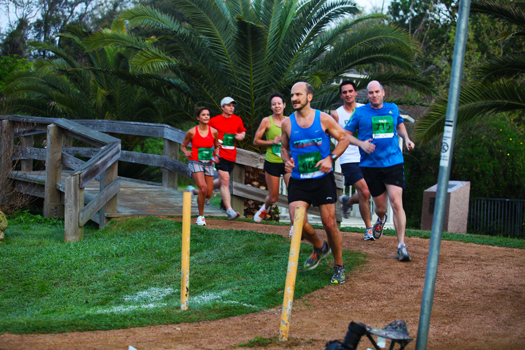Running and Friendly Links
Proper Running Form will Increase Endurance and Speed
Correct Body Posture and Arm Swing Improves Athletic Performance


Proper form is one key to maximizing running potential whether the athlete is sprinting, doing a weekly long run, or especially in long distance races such as the marathon or ultramarathon.
The fact of the matter is that all runners are able to hit the road (or trail) and run with an individual “natural” form, gait, and stride length.
While this usually works fine, because it’s a function of the runner’s biomechanics it usually leaves room for improvement. Very few of us are born with optimal form.
This natural form will alter slightly if the runner takes up a new form of cross training such as Pilates, Yoga, or even a stretching routine. All of these activities will stretch muscles and connective tissues allowing for superior alignment.
This allows the runner to focus on the basic posture when running. Over time, this will increase efficiency, endurance, and the potential for speed.
Efficient Running Body Alignment
The body, from the hips to the top of the head, should be in alignment; that is, it should be possible to draw an imaginary straight line right through the center of the body mass.
That’s not to say perfectly vertical in the sense that a carpenter’s level would read plumb, just straight and not curved. The runner should lean forward slightly, tilting the line.
Why? This puts the chest in position for optimal breathing. Imagine a harness around the chest that’s tethered at a 45 degree angle to a cloud in the sky. Some runners naturally bend a bit at the waist, as if leaning over. This inhibits proper breathing and may put excess strain on back muscles.
Pay Attention to Arm Swing
Swinging the arms is as natural as breathing; most athletes don’t even think about it. But as it turns out, this can also either help or hurt athletic performance depending on execution.
The primary function of the arm swing is a balancing action. Right arm forward, left leg back, and left arm front, right arm back.
The main thing to focus on is that the forearms, from elbow through the wrist, should be horizontal, maintained at approximately a 90 degree angle. Anything too far above or below that level will waste valuable energy and available oxygen that could be going to the leg muscles.
While this might not be a big deal on a training run of even in a 5K, it is imperative to practice this on a daily basis so that it will be natural when it really counts, like in the marathon where every speck of energy conservation is critical.
The Foot Strike; Heel or Forefoot, Pronate or Supinate
The foot strike also comes naturally. Most shoe-wearing runners land on the heel and roll forward and push off the toes, but some both land on and push off the toes. Many barefoot runners naturally come to land on the balls of their feet.
With the heel to toe foot strike, some athletes over-pronate, some over-supinate, and some fall somewhere in between.
It’s not a good idea to alter this intentionally unless under the direction of a podiatrist or sports physiologist. Instead, go to a specialty running store and get an analysis.
Then, the staff will recommend a properly fitted running shoe. Different shoes are engineered to compensate for biomechanics in order to avoid sports injuries.
Work on these running form tips on long runs and easy runs. Eventually, they will come naturally in races.
Recommended Related Articles
- Glycemic_Index Key to Energy and Endurance
- Curing Plantar Fasciitis
- Track Fitness Progress with a Running Log
- Tim Noakes Ten Laws of Running Injuries: Law One
Website © 2010 KSmith Media, LLC; all rights reserved.











